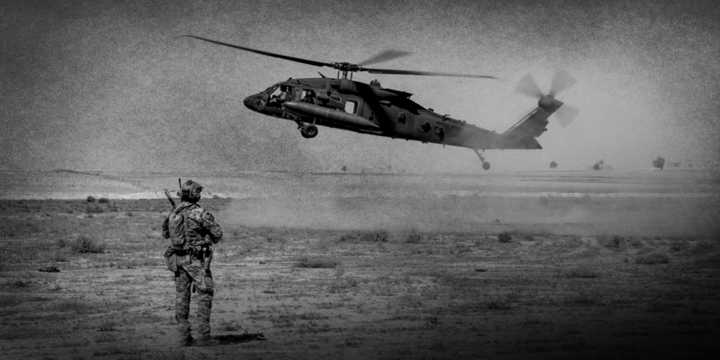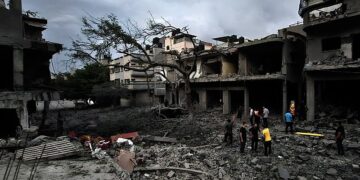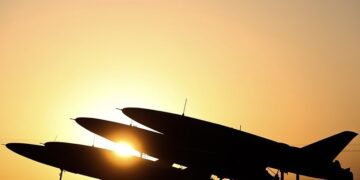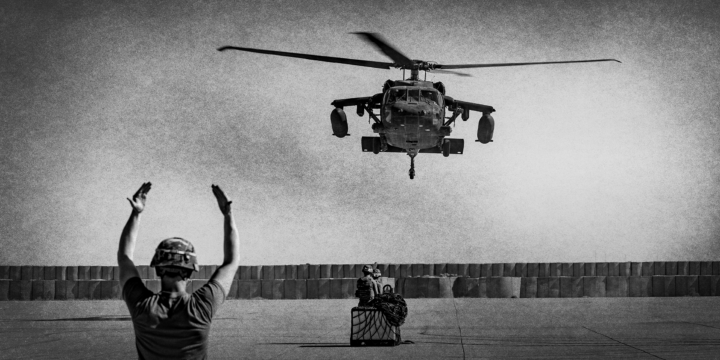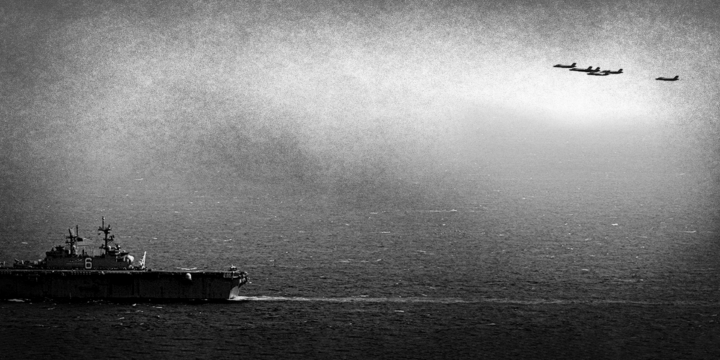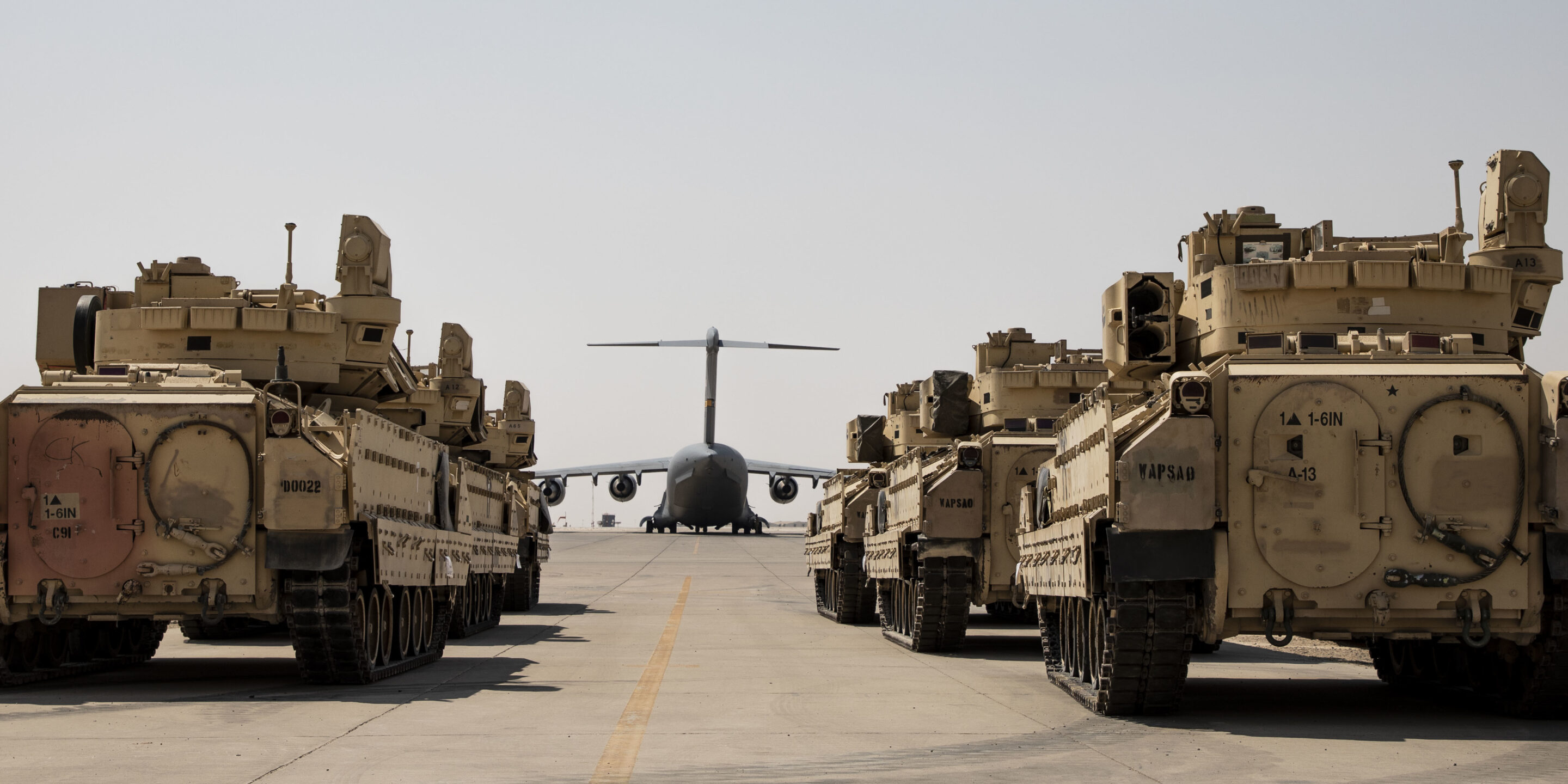
Key points
- Thinking through the process of transiting U.S. forces completely out of the Middle East gives additional depth to conversations on force reductions and further normalizes the idea that the United States can eventually leave the region.
- The underlying social and economic forces that produced the Arab Spring demonstrations of 2011 have not been adequately addressed. They will likely spark additional instability in the years ahead. This fact should affect not only U.S. considerations about decamping the region, but also the pace and speed of a withdrawal.
- Iranian missile capabilities—as demonstrated in the retaliatory attacks following the death of Qassem Soleimani–allow Tehran to increasingly contest U.S. presence in the region. This will be a long-term factor in U.S. basing decisions, regardless of force levels.
- The center of gravity for U.S. presence in the Middle East is the “core four” of Bahrain, Kuwait, Qatar, and the United Arab Emirates (UAE). They account for more than half the total number of U.S. troops in the region and also host the most substantial physical basing infrastructure.
- The direction of a U.S. withdrawal should be away from the center and toward the periphery, with forces flowing from the Persian Gulf west and south toward redoubts in Jordan and Oman.
- A measured timetable of four years would allow the United States to significantly reduce its presence by as much as 50,000 military personnel when rotational deployments (like carrier deployments) are factored in. At the end of the four-year period, the United States would be postured to return to a role as offshore balancer with an option to completely withdraw from the region.
Why plan for something that is not yet agreed?
A consensus is beginning to emerge in the academic and think tank communities that the United States needs to reduce its presence in the Middle East. Some believe complete withdrawal is now necessary due to the change in the region’s strategic relevance.1Though neither explicitly advocates for a full withdrawal of all U.S. military forces from the region, two excellent discussions of the changed strategic relevance of the Middle East can be found in Mara Karlin and Tamara Coffman Wittes, “America’s Middle East Purgatory: The Case for Doing Less,” Foreign Affairs (January/February 2019): 88–100, https://www.foreignaffairs.com/articles/middle-east/2018-12-11/americas-middle-east-purgatory, and Martin Indyk, “The Middle East Isn’t Worth It Anymore,” Wall Street Journal, January 17, 2020, https://www.wsj.com/articles/the-middle-east-isnt-worth-it-anymore-11579277317. This latter view is far from universal–or even mainstream–though, and among advocates for reduced presence there is no unified opinion on what precisely that means.2Within the academic and think tank communities, there are essentially four schools of thought on U.S. force posture in the Middle East. The first retains the current U.S. footprint while offering modest reductions in total number of forces. (See Joshua Rovner and Caitlin Talmadge, “Hegemony, Force Posture, and the Provision of Public Goods: The Once and Future Role of Outside Powers in Securing Persian Gulf Oil,” Security Studies 23 (2014) 548–581, and Bruce Reidel and Michael O’Hanlon, “How to Downsize the U.S. Presence in the Middle East,” Brookings Institution, October 20, 2020, https://www.brookings.edu/blog/order-from-chaos/2020/10/20/how-to-downsize-the-us-presence-in-the-middle-east/.) The second goes further, advocating for deeper cuts and consolidation of bases while maintaining the basic tenet of the United States retaining a military presence on the ground in the Middle East. (See Melissa G. Dalton and Mara E. Karlin, “Toward A Smaller, Smarter Force Posture in the Middle East,” Defense One, August 26, 2018, https://www.defenseone.com/ideas/2018/08/toward-smaller-smarter-force-posture-middle-east/150817/, and Mara E. Karlin and Tamara Cofman Wittes, “How to Do More with Less in the Middle East,” Foreign Affairs, September 15, 2020, https://www.foreignaffairs.com/articles/middle-east/2020-09-15/how-do-more-less-middle-east.) A third perspective argues for far more significant cuts, especially to ground forces, and the retention of very limited assets—like small naval forces, reconnaissance assets, and prepositioned equipment—that would allow the United States to play the role of offshore balancer, as it did for much of the Cold War. (See Emma Ashford, “Unbalanced: Rethinking America’s Commitment to the Middle East,” Strategic Studies Quarterly (Spring 2018): 127–148, https://www.cato.org/sites/cato.org/files/articles/ashford-ssq-november-2018.pdf, and Emma Ashford, “Better Balancing in the Middle East,” in U.S. Grand Strategy in the 21st Century, eds. A. Trevor Thrall and Benjamin H. Friedman [New York: Routledge, 2018]: 179–197.) Finally, a fourth school lobbies for full and complete withdrawal. (See Justin T. Logan, “The Case for Withdrawing from the Middle East,” Defense Priorities, September 2020, https://www.defensepriorities.org/explainers/the-case-for-withdrawing-from-the-middle-east.)
In truth, most intellectual energy is still being spent on why the United States should reduce forces or leave the region, not the specific question of how. This paper tries to rectify that shortcoming by putting forth one possible plan for withdrawal. It is offered with full recognition that a final departure from the Middle East might look quite different. The goal here is not necessarily to get the formula for withdrawal precisely right, but rather to suggest one plausible strategy as a starting point for debate.
Dwight D. Eisenhower’s assertion that plans are worthless but planning is everything is probably one of the most overquoted military aphorisms. But it is so for a reason: It is true. Offering a specific plan—identifying the main parameters of a withdrawal in this case—takes the discourse to a different level. It gives the discussion a verisimilitude it otherwise lacks. In short, talking about how to leave the Middle East affords added weight to discussions over the possibility of departing the region.
A plan is also needed in this particular case because what is being proposed is somewhat unprecedented. The United States has never actually left a major geographic region since the expansion of its global military footprint in the wake of the Second World War. The best historical analogy is when the British quit the Middle East in the late 1960s, a process capped by their transfer to the United States of the naval facility at Manama in Bahrain in 1971.3For more on the British position in the Middle East post-World War II and their eventual departure, see Rovner and Talmadge, “Hegemony,” 560–554; Karol R. Sorby, “Great Powers and the Middle East after World War II (1945–1955),” Asian and African Studies 10, no. 1 (2001): 56–79; and Simon C. Smith, “Britain’s Decision to Withdraw from the Persian Gulf: A Pattern Not a Puzzle,” Journal of Imperial and Commonwealth History 44, no. 2 (December 8, 2015): 328–51.
By publicly annunciating their departure and managing it over a five-year period, the British were able to reduce any instability left in their wake. Of course, they were handing off to another power in the form of America. The United States departing the Middle East will be qualitatively different for that reason. It will leave the region without a primary external balancer for the first time in over a century.
Potential instability in the region is not the only challenge to a U.S. withdrawal. There also will be significant institutional resistance to the idea within the United States itself. Consider the angst and debate entailed in removing the final 5,000 troops from Afghanistan. Quitting an entire region like the Middle East is likely to engender even greater pushback, from the public policy community and constituencies within the U.S. government, including Congress.
U.S. military presence in the Middle East
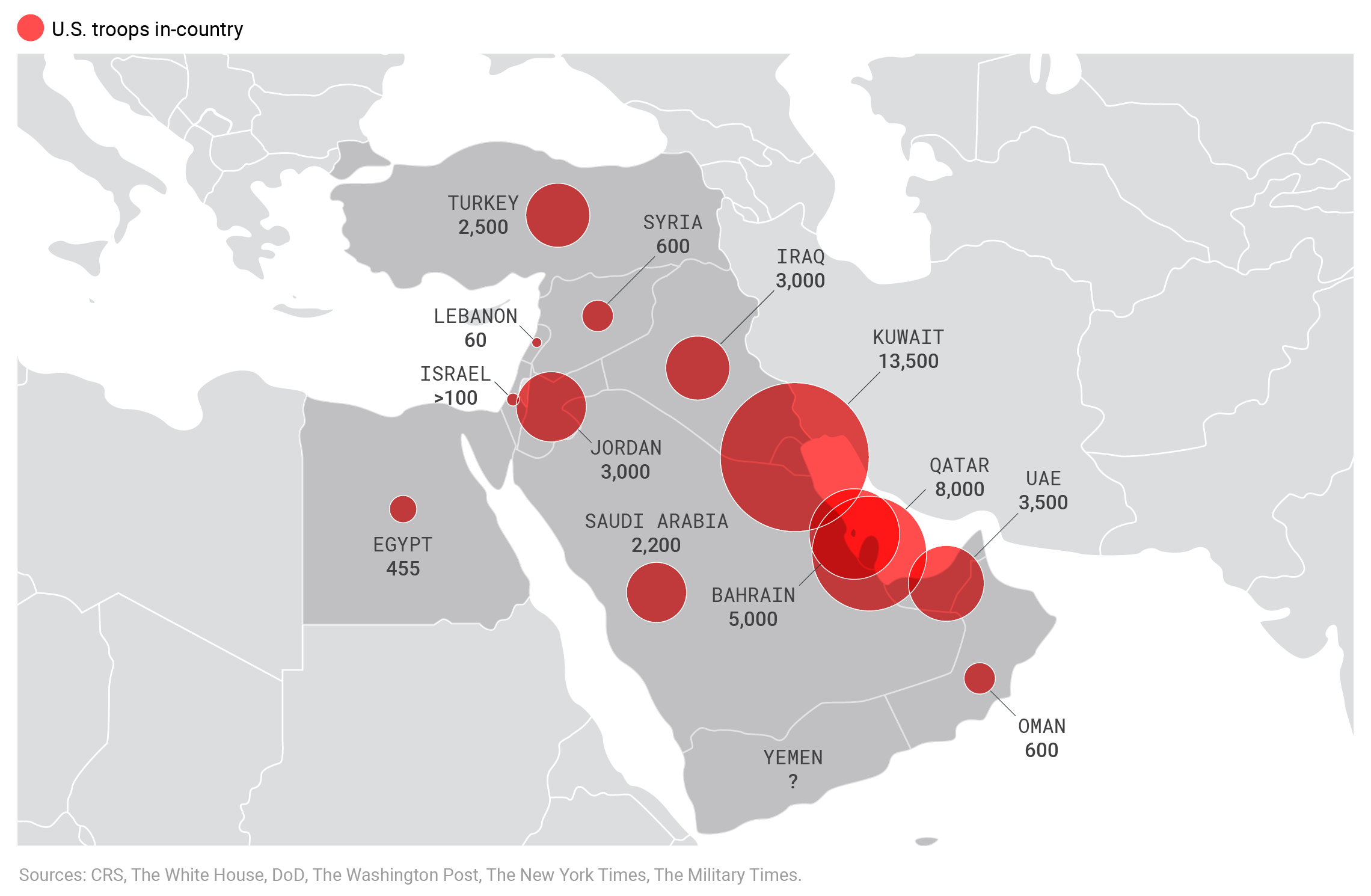
The U.S. states currently has about 42,000 troops on the ground in the Middle East and as many as 65,000 U.S. personnel when including regular rotational deployments by air units and naval forces.
As a result, any plan to fully depart the Middle East will likely need to be tempered by a gradual pace and phased departure. Taking half measures might not be as satisfying to those seeking permanent withdrawal, but they may be a necessary detour to achieving that desired end state.
Moreover, it is still possible to construct a plan that would significantly reduce U.S. presence—both in total number of forces and bases—in as little as four years. The plan put forward in this paper does precisely that, setting up a much-reduced posture that could serve as a waystation for acclimating various opponents to a full U.S. military withdrawal from the Middle East.
It is worth reiterating here that an eventual end to a U.S. military presence should never be equated with a total cessation of U.S. involvement in the Middle East. Nor should such a step be seen as a wholesale renunciation of U.S. military engagement abroad. To the contrary, dramatically reducing U.S. force commitments in the Middle East could significantly ease the burden currently placed on the military services in meeting the operational demands of the various combatant commanders around the globe.4Mackenzie Eaglen, “Putting Combatant Commanders on a Demand Signal Diet,” War on the Rocks, November 9, 2020, https://warontherocks.com/2020/11/putting-combatant-commanders-on-a-demand-signal-diet/. In fact, freeing up forces and funds from the outsized Middle East force posture could be essential to meeting future requirements in East Asia, particularly if U.S. resources are further constrained post-COVID.
The lay of the land—what we would leave
A necessary prerequisite for discussing withdrawal from the Middle East is obviously to understand the scope of the “footprint” the United States needs to divest. It might surprise most Americans that the United States now has almost as many forces in the Middle East as it does in Europe, where it stations approximately 70,000 troops.5Jonathan Masters and William Merrow, “How Is the U.S. Military Pivoting in Europe?” Council on Foreign Relations, September 23, 2020, https://www.cfr.org/in-brief/how-us-military-pivoting-europe. In the Middle East, a detailed count reveals the United States currently has about 42,000 troops on the ground, but regular rotational deployments by air units and large naval forces like carrier battle groups (CVBGs) mean that as many as 65,000 U.S. personnel can be in the Middle East at any time.6The figure of 42,000 is derived from the specific survey of U.S. forces in each of fourteen countries as laid out in this section of the paper. The high-end figure of 65,000, which includes rotational deployments, is taken from Eric Schmitt, “U.S. to Reduce Troop Levels in Iraq to 3,000,” New York Times, September 9, 2020, https://www.nytimes.com/2020/09/09/us/politics/iraq-troops-trump.html.
Active combat zones
On land, these forces are based in as many as fourteen countries. Indeed, outside of Iran, there is no state in the Middle East where the United States does not have at least a small contingent of forces. The one possible exception is Yemen, where it is unclear if the United States still maintains “a small number of United States military personnel” to conduct operations against ISIS and Al-Qaeda in that country—as it did as of December 2019.7“Text of a Letter from the President to the Speaker of the House of Representatives and the President Pro Tempore of the Senate,” The White House, December 11, 2019, https://www.whitehouse.gov/briefings-statements/text-letter-president-speaker-house-representatives-president-pro-tempore-senate-8/. There has never been a public assertion that these units were withdrawn, nor has there been an official update if they are still deployed in-country. As recently as February 2020, though, counterterrorist raids were being conducted by U.S. personnel on Yemeni soil.8“Statement from the President,” The White House, February 6, 2020, https://www.whitehouse.gov/briefings-statements/statement-from-the-president-13/.
If U.S. forces remain engaged there, it would make Yemen one of three areas in the Middle East where U.S. forces are deployed in active combat zones. The United States also maintains 600 combat troops on the ground in Syria, having actually added an additional 100 personnel to the extant force of 500 following the collision between U.S. and Russian mechanized forces in August 2020.9Eric Schmitt, “U.S. Sending More Troops to Syria to Counter Russia,” New York Times, September 18, 2020, https://www.nytimes.com/2020/09/18/us/politics/us-troops-syria-russia.html. And, of course, about 3,000 ground troops still remain in Iraq as of this writing, scheduled to be reduced to 2,500 under cuts announced in the final weeks of the Trump administration.10Schmitt, “U.S. to Reduce Troop Levels in Iraq to 3,000”; Dan Lamothe and Missy Ryan, “As Trump’s Term Nears Close, Administration Announces Troop Level Cuts in Afghanistan and Iraq,” Washington Post, November 17, 2020, https://www.washingtonpost.com/national-security/trump-troop-cut-afghanistan-iraq/2020/11/17/ed6f3f80-28fa-11eb-b847-66c66ace1afb_story.html.
The core four: Kuwait, Bahrain, Qatar, and the UAE
While those three deployments are most significant because of the active danger to the troops involved, they are among the least relevant in the region numerically. Instead, the largest concentration of U.S. manpower lies in a berm of bases on the western shore of the Persian Gulf, spread out over four small Arab countries: Bahrain, Kuwait, Qatar, and the United Arab Emirates (UAE). These four states account for more than half the total U.S. forces in the region and also house the most robust physical infrastructure of the U.S. basing footprint.
The force at Al Dhafra Air Base in the UAE is the most modest of these deployments, at about 3,500.11U.S. Library of Congress, Congressional Research Service, The United Arab Emirates (UAE): Issues for U.S. Policy, RS21852 (September 4, 2020): 14, https://fas.org/sgp/crs/mideast/RS21852.pdf. But the base itself can host an array of air power, such as surveillance platforms like the U-2 and AWACS and combat aircraft like the B-52, F-22, and F-35, as well as unmanned assets such as Global Hawk.12U.S. Library of Congress, The United Arab Emirates (UAE), 14.
Force levels rise as one moves to neighboring Qatar, where there are approximately 8,000 U.S. personnel.13U.S. Library of Congress, Congressional Research Service, Qatar: Governance, Security, and U.S. Policy, R44533 (August 31, 2020): 12, https://fas.org/sgp/crs/mideast/R44533.pdf. The centerpiece of the U.S. deployment in Qatar is Al Udeid Air Base which has been a major regional air hub since the early days of the Iraq War and, like Al Dhafra, can accommodate most assets in the U.S. Air Force’s inventory. Al Udeid also serves as the forward headquarters for U.S. Central Command (CENTCOM).
Moving north and west along the Gulf’s coast is the island state of Bahrain. Located in the capital of Manama is the headquarters of the U.S. Fifth Fleet and Naval Support Activity Bahrain (NSA-Bahrain), a sprawling naval base that has grown from a mere 10 acres at the time of the 1991 Gulf War to its current size of 150 acres.14U.S. Library of Congress, Congressional Research Service, Bahrain: Unrest, Security, and U.S. Policy, 95-1013 (September 25, 2020): 12, https://fas.org/sgp/crs/mideast/95-1013.pdf. Nearby is Shaykh Isa Air Base, another important air transit point for U.S. troops and logistics. Overall, some 5,000 U.S. military personnel live in Manama.15U.S. Library of Congress, Bahrain, 11. Most are comingled amongst the city’s population, a rare arrangement within the region where U.S. forces are normally cordoned off in separate housing.16Richard McDaniel, “No ‘Plan B’: U.S. Strategic Access in the Middle East and the Question of Bahrain,” Brookings Institution, 2013, 16–17, https://www.brookings.edu/wp-content/uploads/2016/06/24-us-strategic-access-middle-east-bahrain-mcdaniel.pdf.
Current U.S. military facilities in the “core four” countries
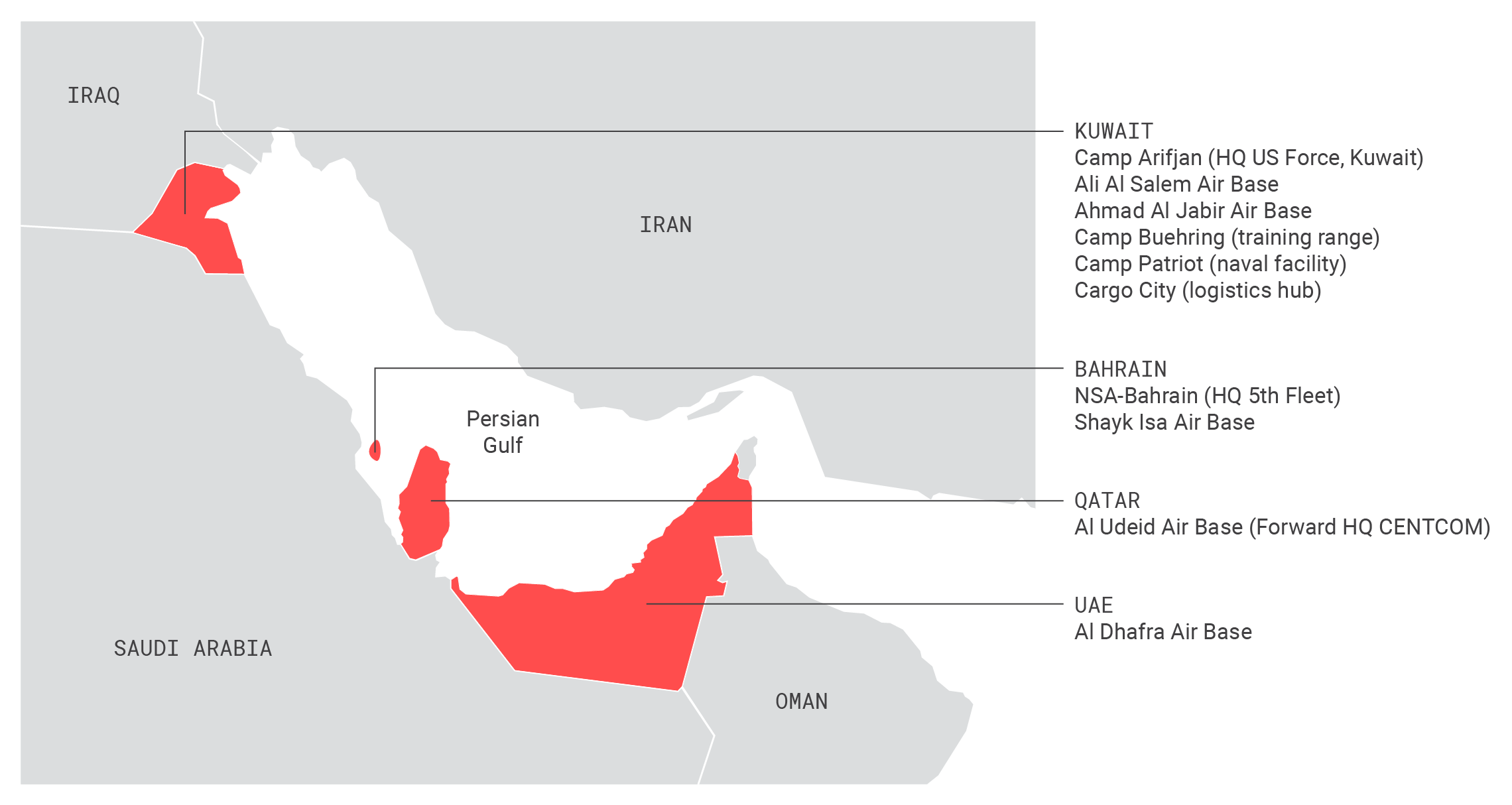
Bahrain, Kuwait, Qatar, and the UAE account for more than half the total U.S. forces in the region and also house the most robust physical infrastructure of the U.S. basing footprint.
Finally, at the northern end of the Gulf lies Kuwait, the most significant regional country from a basing perspective. Kuwait hosts 13,500 U.S. troops, placing it fourth behind only Germany, Japan, and South Korea for largest U.S. overseas deployment.17U.S. Library of Congress, Congressional Research Service, Kuwait: Governance, Security, and U.S. Policy, RS21513 (October 14, 2020) 7–8, https://fas.org/sgp/crs/mideast/RS21513.pdf. These are dispersed over a half dozen facilities, the two most prominent being Camp Arifjan, the headquarters of U.S. forces in Kuwait, and Ali al-Salem Air Base. U.S. forces also have access to a training range, Camp Buehring; a naval facility, Camp Patriot; and a second air base, Ahmad al-Jabir.18U.S. Library of Congress, Kuwait, 8. Finally, there is “Cargo City,” an adjunct of Kuwait International Airport set aside for U.S. use along with 33,000 square meters of storage space; it is the United States largest aerial logistical hub in the Middle East.19Brian W. Everstine, “Cargo City Opens in Kuwait,” Air Power Magazine, May 28, 2019, https://www.airforcemag.com/cargo-city-opens-in-kuwait/.
The northwest bases
Outside the “core four” on the western shores of the Persian Gulf, there also is an important salient of basing infrastructure in the northwest region of the Middle East. It consists primarily of two air bases—Incirlik in Turkey and Muwaffaq Salti in Jordan.
The first of these, Incirlik, is the United States’ longest-standing base in the region, dating back to the 1950s, although for most of the Cold War it was used primarily for NATO operations—that is, oriented “northward” toward containing the threat from the Soviet Union and Warsaw Pact. It was only with the Cold War’s end that Incirlik took on a more prominent role as a U.S. hub in the Middle East, beginning with the Gulf War and continuing up through the fight against ISIS. However, Turkish permission for use of Incirlik for non-NATO operations has not always been reliable, including the last-minute withholding of the base during the 2003 invasion of Iraq. Today, the United States has approximately 1,465 troops at Incirlik and an estimated total of 2,500 military personnel in Turkey more broadly.20“Incirlik AB—Quick Overview,” Military Installations, https://installations.militaryonesource.mil/military-installation/incirlik-ab, and Miriam Berger, “Where U.S. Troops Are in the Middle East and Afghanistan, Visualized,” Washington Post, January 4, 2020, https://www.washingtonpost.com/world/where-us-troops-are-in-the-middle-east-and-could-now-be-a-target-visualized/2020/01/04/1a6233ee-2f3c-11ea-9b60-817cc18cf173_story.html.
In contrast, Muwaffaq Salti Air Base near Azraq, Jordan, is among the newest bases for U.S. forces in the Middle East, having become an important operational center in the campaign against ISIS, beginning around 2013. Its relevance has only increased in the western half of the region as relations between the United States and Turkey soured over a host of issues, casting further doubt on reliable access to Incirlik. The United States has undertaken a multiyear, multimillion-dollar construction project to significantly expand and upgrade Muwaffaq Salti’s capacity.21In FY2018 alone, $140 million was invested in improvements to Muwaffaq Salti Air Base; subsequent contracting documents call for a similar level of future investment to add additional mission-specific aprons and to improve housing, cargo storage, and revetments. See Joseph Trevithick, “Docs Show U.S. To Massively Expand Footprint at Jordanian Air Base Amid Spats With Turkey, Iraq,” Drive, January 14, 2019, https://www.thedrive.com/the-war-zone/25955/docs-show-us-to-massively-expand-footprint-at-jordanian-air-base-amid-spats-with-turkey-iraq. An estimated 3,000 U.S. military personnel are currently in Azraq.22Berger, “Where U.S. Troops Are in the Middle East and Afghanistan, Visualized.”
Technical, advising, and peacekeeping missions
Deployments in five other countries round out the expansive U.S.-Middle East footprint. The most substantial of these are currently deployed in Saudi Arabia. Although U.S. forces left the Kingdom in 2003 during the early days of the Iraq War by “mutual agreement,” they returned in smaller numbers in 2019, following Houthi rebel attacks on Saudi oil infrastructure. That force has subsequently been reduced with the withdrawal of two (of four) Patriot batteries, but there are still an estimated 2,200 U.S. troops based in Saudi Arabia.23This assumes a reduction in 300 troops (those supporting the Patriot batteries) from the established estimate of 2,500 troops total having been based in Saudi Arabia. See Lolita C. Baldor, “U.S. Pulls Patriot Missiles, Fighter Aircraft from Saudi Arabia Amid Dispute,” Military Times, May 7, 2020, https://www.militarytimes.com/news/your-military/2020/05/07/us-pulls-patriot-missiles-fighter-aircraft-from-saudi-arabia-amid-dispute/.
The remaining deployments are more modest and generally have a specific technical focus or mission. These include a few dozen U.S. military personnel in Israel assisting with ballistic missile defense, specifically the operation of a powerful X-band radar in the Negev Desert.24John Vandiver, “U.S. Troops Deployed to Israel Get a New Barracks,” Stars & Stripes, September 19, 2017, https://www.stripes.com/news/us-troops-deployed-to-israel-get-a-new-barracks-1.488440. About 60 troops are deployed in Lebanon as counterterrorism (CT) advisers.25“Text of a Letter,” The White House. There also are 455 troops based in Egypt’s Sinai Peninsula as part of the Multinational Force and Observers (MFO), an international peacekeeping body the United States has contributed to since its inception in 1981.26“Text of a Letter,” The White House.
Then there is Oman. The country served as an important launching point for strikes in the early days of the Afghan War; since then it has continued to be a useful airbridge for movement in and out of the greater Middle East.27U.S. Library of Congress, Oman: Politics, Security, and Policy, RS21534 (June 17, 2020): 13, https://fas.org/sgp/crs/mideast/RS21534.pdf. The United States does not maintain a dedicated base in Oman, but reportedly has access to four Omani air fields—on Masirah Island and at Muscat, Musnannah, and Thumrait.28U.S. Library of Congress, Congressional Research Service, Oman, 13. In 2019, access was further expanded, when the United States and Oman signed an agreement granting use of the ports of Salalah and Duqm.29Sune Engel Rasmussen and Gordon Lubold, “Omani Ports Give U.S. Navy Greater Control Over Strategic Waterway Near Iran,” Wall Street Journal, March 24, 2019, https://www.wsj.com/articles/omani-ports-give-u-s-navy-greater-control-over-strategic-waterway-near-iran-11553448471. This development is not insignificant. There are only a handful of ports in the Middle East that are deep enough to accommodate an aircraft carrier.30McDaniel, “No ‘Plan B’: U.S. Strategic Access in the Middle East and the Question of Bahrain,” 15–16. Duqm is one of these.31U.S. Library of Congress, Oman, 13.
The parameters of withdrawal
In considering a plan for withdrawal from the Middle East, it is an obvious point, but one nonetheless worth making, that there are no legal impediments to the United States leaving. Although many of the states touched on above–including Bahrain, Egypt, Israel, and Kuwait–hold the official status of Major Non-NATO Ally (or MNNA), the distinction holds no treaty-bound commitments. That is, MNNA is simply a designation that has more to do with defense industry collaboration and other forms of materiel security cooperation.32“Major Non-NATO Ally Status,” Department of State, January 30, 2020, https://www.state.gov/major-non-nato-ally-status/. Despite the presence of “NATO” in the title, there is nothing similar to the Article 5 guarantee that would compel the United States to defend any state in the Middle East, much less maintain forces on their territory to do so. Leaving is a matter of policy choice and, more importantly, the political will to implement it.
Logistically, the challenges are significant but far from insurmountable. As the preceding survey indicates, U.S. regional presence is both deep and dispersed. That said, total number of forces is not unduly prohibitive when it comes to looking at an expeditious departure from the region. At the end of the Iraq War, the United States went from approximately 96,000 troops in-country to zero in the span of two years.33Specifically, at the start of 2010, the United States had 95,900 troops on the ground in Iraq; all were withdrawn by the end of 2011. See “Table 3. U.S. Armed Forces and Contractor Personnel in Iraq,” in Library of Congress, Congressional Research Service, Department of Defense Contractor and Troop Levels in Afghanistan and Iraq: 2007–2018, R44116 (May 10, 2019): 13, https://fas.org/sgp/crs/natsec/R44116.pdf. A withdrawal of 42,000 troops from the broader Middle East could therefore conceivably be done in a year, or perhaps more comfortably in 18 to 24 months if one wanted to make it less of a logistical sprint.
Additional force levels would be reduced simply by stopping rotational deployments, in particular altering requirements ending the presence of carrier battle groups, each of which has roughly 7,500 personnel in its complement. Over the years, CENTCOM and the Navy have had a tortured relationship over demand for carriers and the availability of these platforms.34David B. Larter, “What If the U.S. Stopped Sending Aircraft Carriers to the Arabian Gulf?” Defense News, May 2, 2018, https://www.defensenews.com/naval/2018/05/02/what-if-the-us-stopped-sending-aircraft-carriers-to-the-arabian-gulf/; David B. Larter, “With Iran Tensions High, a U.S. Military Command Pushes a Dubious Carrier Strategy,” Defense News, March 24, 2020, https://www.defensenews.com/naval/2020/03/24/with-iran-tensions-high-centcom-pushes-a-dubious-carrier-strategy/; Megan Eckstein, “No Margin Left: Overworked Carrier Force Struggles to Maintain Deployments After Decades of Overuse,” USNI News, November 12, 2020, https://news.usni.org/2020/11/12/no-margin-left-overworked-carrier-force-struggles-to-maintain-deployments-after-decades-of-overuse. CENTCOM’s requirement to have two CVBGs on station—a policy that ebbed over the years but was reinstituted in 2020 amidst renewed tensions with Iran35Larter, “With Iran Tensions High, a U.S. Military Command Pushes a Dubious Carrier Strategy.”—means that at least 15,000 U.S. personnel are afloat in the region at a time, in addition to the estimated 42,000 troops based ashore as described above.
But the basic mechanics of getting forces and equipment out of the region are not the only considerations. In this regard, the attempted withdrawal from Syria in the fall of 2017 provides a cautionary example. The instinct to leave was correct, but the haphazard way in which it was implemented only raised questions about its wisdom while also building support for the residual presence that still operates in that country to this day.
When looking at departing the broader Middle East, a mad dash to the door is an unlikely sell from the U.S. side and could also create unnecessary sources of instability in a region that already has an ample supply. Instead, a clearly enunciated strategy is needed, and it will likely have to play out over a period longer than the bare minimum needed to simply evacuate personnel and equipment. In general, three factors will set the parameters of any withdrawal plan: focus, scope, and timing.
Focus: The Gulf is U.S. presence
In looking at the broad footprint of U.S. presence in the Middle East, it quickly becomes clear that the center of gravity is the “core four” of Bahrain, Kuwait, Qatar, and the UAE. Outside of them, the U.S. regional presence is largely transient and ancillary (at least in terms of numbers, if not risks to U.S. forces still in active combat zones.) The smallest deployment from among the Gulf grouping—the 3,500 troops at Al Dhafra in the UAE—is still bigger than any one of the next four largest in the rest of the region—Iraq, Jordan, Saudi Arabia, and Turkey. When talking about the United States “leaving the Middle East,” the real issue is therefore leaving the Persian Gulf. How the bases in these “core four” are divested will characterize the heart of any plan to decamp the region.
Part of this is obviously due to the preponderance of forces physically based there, but it there are other important considerations. For example, standing down NSA-Bahrain in Manama would implicitly entail a decision to decrease (if not end entirely) rotational naval deployments into the Gulf. To leave Bahrain is essentially to dissolve the Fifth Fleet. Yes, there are other ports in the Persian Gulf that can handle major U.S. surface combatants, but they are facilities open to all, without the dedicated, U.S.-only berths and specialized maintenance facilities offered at NSA-Bahrain.36McDaniel, “No ‘Plan B’: U.S. Strategic Access in the Middle East and the Question of Bahrain,” 15–16, 18–19. From U.S. Navy’s perspective, the difference between Manama’s facilities and other regional ports is akin to owning a private jet versus flying commercial. The symbolism of abandoning one of its oldest bases—and the lynchpin of its naval presence in the region—would be the clearest indicator of the changed importance of the Middle East in U.S. strategic thinking.
A withdrawal from these four small countries would also constitute a spiritual decoupling of the United States from the Saudi-led Gulf Cooperation Council (GCC), the six-nation bloc of Arab states formed in 1981. U.S. presence in the smaller GCC states has been the physical manifestation of its partnership with the Arab world for the past thirty years. It serves as a daily symbol of the mechanics of that relationship even as U.S. bilateral ties to Saudi Arabia receives more high-profile attention as the public face of the entente. Leaving a country like Jordan or Iraq is not unimportant, but decamping from Kuwait or Bahrain will be seismic from the perspective of U.S. long-term commitment to the region.
All of that said, the relevance of this quartet of states is likely to change even without action by the United States. Iran’s attacks on U.S. bases in Iraq in response to the killing of Qassem Soleimani revealed a more effective missile capability than it hitherto had demonstrated. The Fateh-110 ballistic missile used in Iraq proved to be impressively accurate.37Ian Williams, “Uncomfortable Lessons: Reassessing Iran’s Missile Attack,” Center for Strategic and International Studies, February 6, 2020, https://www.csis.org/analysis/uncomfortable-lessons-reassessing-irans-missile-attack, and Stratford Worldview, “Yes, Iran’s Ballistic Missiles Are Pretty Accurate,” National Interest, August 22, 2020, https://nationalinterest.org/blog/reboot/yes-irans-ballistic-missiles-are-pretty-accurate-167511. It showed that the weapon could be used to target specific military facilities in order to disrupt operations and not just serve as more random “terror weapons” like the old, inaccurate Scud.38Victor Abramowicz, “The Impact of Accuracy,” Interpreter, January 16, 2020, https://www.lowyinstitute.org/the-interpreter/impact-accuracy.
The Fateh’s range is estimated at between 300km and 500 km, which places large swaths of Iraq, as well as the “core four” of Gulf basing states squarely within its reach.39See “Iranian Ballistic Missile Ranges” range-arc map in Defense Intelligence Agency, Iran Military Power (Washington, DC: Government Printing Office, 2019): 43, https://www.dia.mil/Portals/27/Documents/News/Military%20Power%20Publications/Iran_Military_Power_LR.pdf. Iran also has longer-range missiles in its arsenal, albeit older, liquid-fueled designs with far less accuracy and reliability than the Fateh-110 and its variants.40Defense Intelligence Agency, Iran Military Power, 30–31, 43–36.
Of course, the United States and many of the GCC states do operate active missile defenses, like Patriot and the Terminal High Altitude Air Defense (THAAD) system; U.S. destroyers and cruisers also operate the Aegis missile defense system at sea. These can certainly mitigate, if not entirely negate, Iranian missile threats. But they also cannot be everywhere all the time, as their absence from the Al Asad Air Base in Iraq indicates. Already, the Fateh-110 threat appears to have changed how the U.S. Air Force deploys strategic bombers to the region; it has moved them back from Al Udeid in Qatar to Diego Garcia, an atoll located 2,500 miles to the south, in direct response to the Iranian missile threat.41Brian W. Everstine, “AFGSC’s New Plan to Deploy Bombers Across the Globe,” Air Force Magazine, April 29, 2020, https://www.airforcemag.com/afgscs-new-plan-to-deploy-bombers-across-the-globe/; Brian W. Everstine, “Iranian Ballistic Missile Launch Briefly Raises Alarm at Al Udeid, Al Dhafra,” Air Force Magazine, July 28, 2020, https://www.airforcemag.com/iranian-ballistic-missile-launch-briefly-raises-alarm-at-al-udeid-al-dhafra/.
The point is not that the Iranian missile threat is absolute, but rather that Tehran can use it to contest U.S. presence in the Gulf–both on land and at sea–in an increasingly credible way. That must factor into U.S. basing decisions regardless of the overall future of its presence in the region.42For example, the Iranian missile challenge factors prominently in the discussion of another alternative Middle East basing footprint put forward as this paper was going to publication. See Becca Wasser and Aaron Stein, “Small, Distributed, and Secure: A New Basing Architecture for the Middle East,” War on the Rocks, December 16, 2020, https://warontherocks.com/2020/12/small-distributed-and-secure-a-new-basing-architecture-for-the-middle-east/. There is likely to be a slow shift westward and south out of the Fateh’s range arc, even if the United States maintains its regional presence. That should also be the general direction of a U.S. withdrawal.
Range of Iranian Fateh-110 missiles
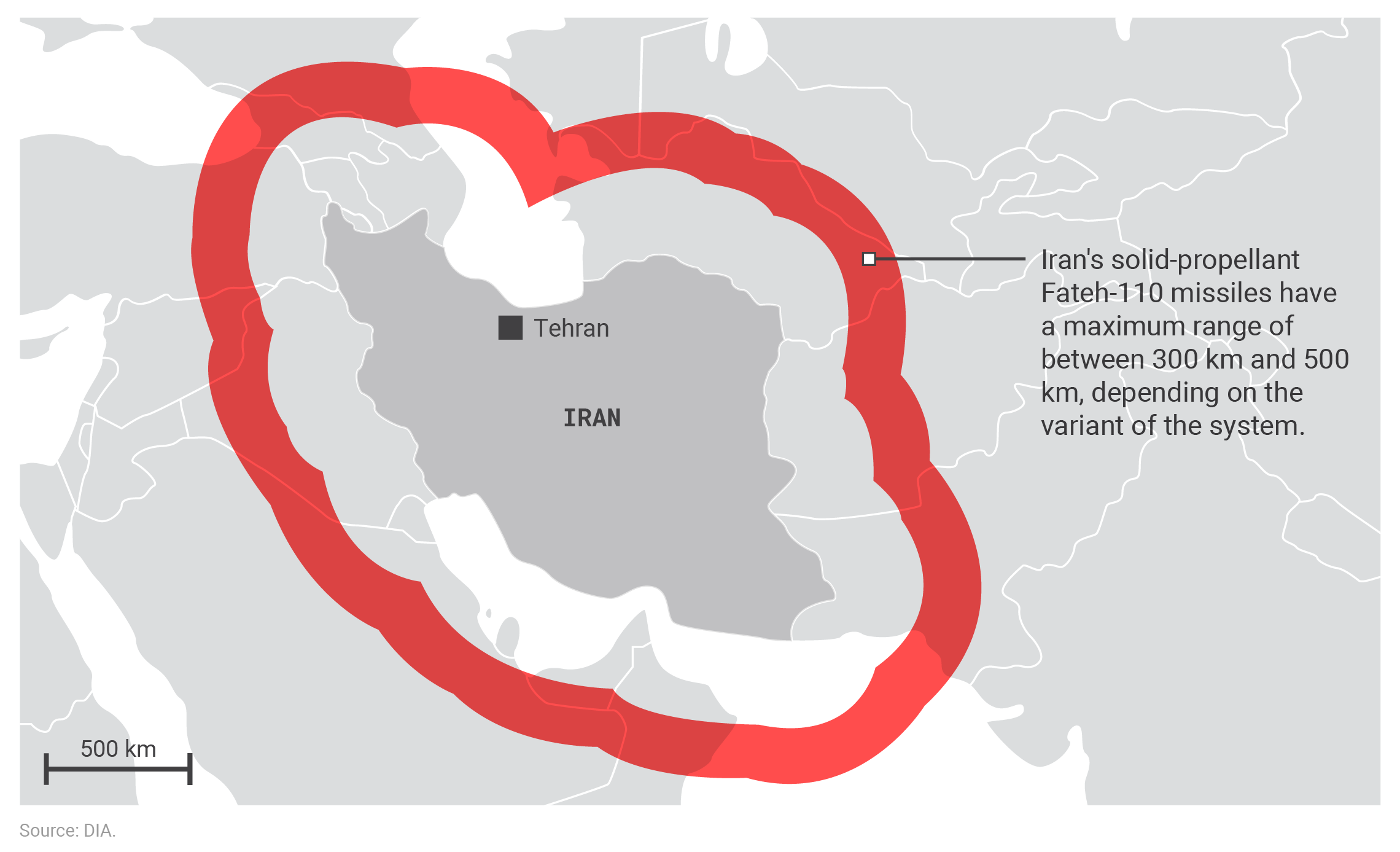
The range of Fateh-110 short-range ballistic missiles gives Tehran the capability to strike U.S. forces currently stationed in or near Bahrain, Kuwait, Qatar, and the UAE.
Scope: How far is gone?
The second crucial factor in a withdrawal plan will be scope; or, put simply, how far is gone? This may seem like a rudimentary question, but when one looks at various U.S. efforts to leave specific countries—be it Afghanistan, Iraq, or Syria—it is not overly cautious to ask what is truly meant by “withdrawal.” There are always hedges and caveats in play, often in the form of things like prepositioned equipment stocks (to facilitate an eventual return by larger forces) or the maintenance of small, residual troop formations, such as retaining special operations forces in-country for CT missions.
To date, the debate over U.S. presence has mostly been between two concepts: offshore balancing and forward engagement.43Micah Zenko, “U.S. Policy in the Middle East: An Appraisal,” Chatham House Research Paper, October 2018, 7–8, https://www.chathamhouse.org/sites/default/files/publications/research/2018-10-18-us-military-policy-middle-east-zenko-final.pdf. The latter accurately describes the U.S. policy and posture since 1991—that is, maintaining robust military presence in the region, nominally as a means to shape and influence events in ways conducive to U.S. interests. In contrast, “offshore balancing” best describes the U.S. approach for most of the Cold War, when it maintained only two bases in the Middle East and relied on an array of other instruments of national power—including economic power, diplomacy, covert action, and security assistance—to exert its influence.44Mike Sweeney, “Considering the ‘Zero Option’—Cold War Lessons on U.S. Basing in the Middle East,” Defense Priorities, March 2020, https://www.defensepriorities.org/explainers/considering-the-zero-option. These were occasionally reinforced by the direct use of military force and temporary deployments—e.g., Lebanon in 1958 and the early 1980s, the 1973 resupply of Israel during the Yom Kippur War, airstrikes in Libya in 1986, and the Tanker War of 1987–88—but without permanent standing forces or numerous bases.
The position of this paper is to move beyond both of these concepts to a full and complete divestiture of a role for U.S. military force in the region. In doing so, it might be necessary to again adopt a posture that would resemble offshore balancing during an interregnum period before the United States has completely left the region. But the final end state should not include leaving behind either prepositioned equipment or residual CT forces.
U.S. military bases in the Middle East during the Cold War
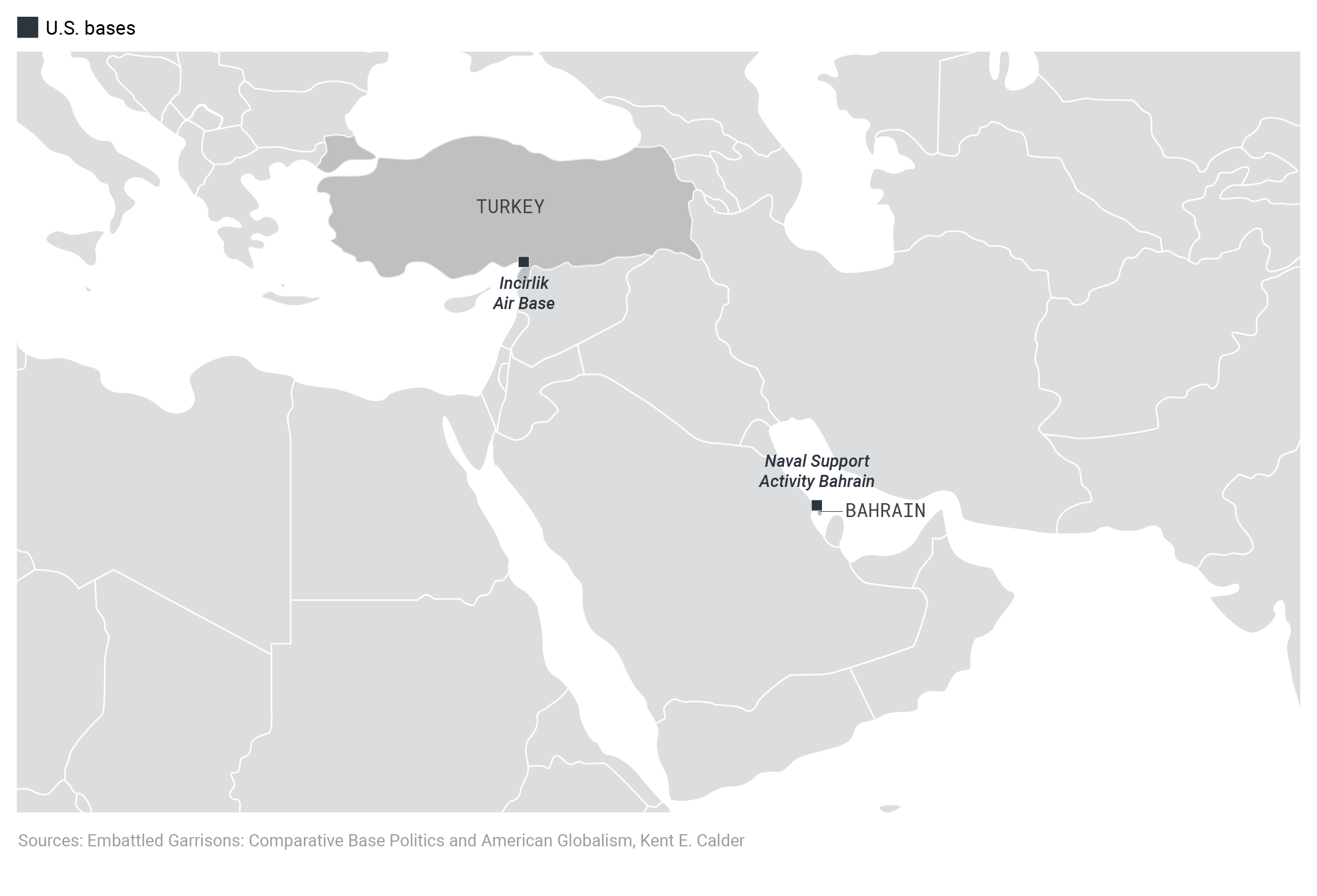
During the Cold War, the U.S. maintained just two military bases in the Middle East. Incirlik in Turkey was focused on Europe’s security, while Bahrain supported minimal naval vessels for offshore operations.
If the premise for a withdrawal of U.S. forces is that the Middle East is of much diminished strategic importance than why keep equipment to support a return? The United States does not preposition a brigade’s worth of equipment in Brazil because no one thinks there is anything worth fighting a major war over in South America. Part of acknowledging that the Middle East’s status has changed is accepting that it is okay for U.S. forces to leave in a manner that is both definitive and unconditional.
This possibility is in keeping with a sober understanding of the limits on the United States force structure and economic resources. The United States can ill-afford to fight another protracted ground war in Southwest Asia. So why prepare for one with prepositioned equipment and munition stocks? Why leave behind residual counterterrorism forces that have the potential to suck America back into a larger conflict?
Prepositioned stockpiles and CT forces carry smaller footprints than large-scale troop deployments but produce similar political entanglements. They make the United States beholden to the host regime and both constrain the United States in its interactions with that state and risk ensnaring it in conflicts it could otherwise avoid. It is not clear that 1,000 troops cannot involve the United States in a war any less easily than 10,000. It is the ties to the regional regimes that any commitment of troops entail that are the problem. If the United States leaves the Middle East, gone should mean gone.
Timing: Racing instability
The final question to answer is how quickly the U.S. departure can be conducted in a responsible manner. Part of the equation, as touched on above, is the comfort level from the U.S. side. Leaving the Middle East will constitute a fundamental shift in not only the United States global military posture, but also its strategic thinking. It is understandable to want to hedge against unwanted consequences and provide ample time to monitor the effects of the move, to allow for a slow easing off rather than a rapid transition. That is why in conceiving a timeline for withdrawal, the initial instinct was to go long, letting a withdrawal play out over a ten- to fifteen-year timespan.45Mike Sweeney, “Nothing is Forever: When the U.S. Military Eventually Leaves the Middle East, It’s Going to Need a Plan,” Modern War Institute, July 15, 2019, https://mwi.usma.edu/nothing-forever-us-military-eventually-leaves-middle-east-going-need-plan/.
This is complicated by the internal dynamics in the region, however. The main justification for leaving the Middle East is its decreased strategic importance. Yet a close second could be the likelihood that additional widespread instability is almost certainly in the region’s future. The social and economic strains that led to the 2011 uprisings known as the Arab Spring have never been adequately addressed, with the possible exception of the state where they began, Tunisia.46Sarah E. Yerkes, “The Tunisia Model,” Foreign Affairs 98, no. 6 (2019): 67–72, https://www.foreignaffairs.com/articles/tunisia/2019-10-15/tunisia-model. Elsewhere, regional leaders have largely responded with increased political repression mated to a few modest reforms. And, in a one case, an authoritarian leader, Egypt’s Hosni Mubarak, was simply swapped out for a new autocrat, Abdel Fattah Al Sisi.
There is no reason to believe the forces that erupted in 2011 will not manifest again, perhaps in a more substantive and lasting way.47Marwan Muasher, “The Next Arab Uprising,” Foreign Affairs 97, no. 6 (2018): 113–24, https://www.foreignaffairs.com/articles/middle-east/2018-10-15/next-arab-uprising; Maha Yahya, “The Middle East’s Lost Decades,” Foreign Affairs 98, no. 6 (2019): 48–55, https://www.foreignaffairs.com/articles/middle-east/2019-10-15/middle-easts-lost-decades. It is not scientific proof, of course, but it is worth contemplating how the Prague Spring of 1968 in many ways served as the tremor that grew into the earthquake of the 1989 revolutions in Eastern Europe. “Black swan events” are seldom that.48Andrew A. Hill, “Black Swan, Red Beard: Recognizing the Unexpected,” War Room, United States Army War College, June 22, 2017, https://warroom.armywarcollege.edu/articles/black_swan_red_beard/. More often than not, “sudden” revolutions are the result of patterns that can be clearly be seen after the fact—and before with a modicum of insight.
The continued dependence of the region on the rentier model—by which states essentially bribe their population into accepting authoritarianism with the fruits of energy profits—is unsustainable, particularly given the trend in oil prices over the past decade.49Muasher, “The Next Arab Uprising.” For an extensive discussion of various facets of the rentier model in the region, see also The Politics of Rentier States in the Gulf, Project on Middle East Political Science, January 2019, https://www.bakerinstitute.org/media/files/files/df77a3f0/krane-subsidies-pomeps.pdf. Beyond that, it is simply worth acknowledging that regimes that function like nineteenth-century monarchies (at best) are increasingly untenable in the twenty-first century. Sooner or later, lasting change will come to Middle Eastern society and it might be best if the United States observed it from afar. The experience of Bahrain in 2011—where the U.S. government first warned Manama against overt repression of protesters and then had to stand by while precisely that occurred—is a cautionary tale, one that could conceivably be played out on larger stage at some point in the future.50Ross Colvin, “Obama Speaks to Bahrain’s King, Urges Restraint,” Reuters, February 18, 2011, https://www.reuters.com/article/us-bahrain-usa/obama-speaks-to-bahrains-king-urges-restraint-idUSTRE71H5L420110219; Ethan Brockman and Michael Slackman, “Saudi Troops Enter Bahrain to Help Put Down Unrest,” New York Times, March 14, 2011, https://www.nytimes.com/2011/03/15/world/middleeast/15bahrain.html; Max Fisher, “Obama’s UN Address and the Bahrain Exception,” Atlantic, September 21, 2011, https://www.theatlantic.com/international/archive/2011/09/obamas-un-address-and-the-bahrain-exception/245467/.
In short, dragging out a U.S. withdrawal over a decade-and-a-half might provide greater strategic insight about its impact, but also risks leaving smaller, more vulnerable U.S. deployments on the ground amidst growing instability and societal change. And it could create new instances where the United States has to compromise its moral stance in deference to host-nation regimes employing openly repressive tactics. “Pulling the band-aid off quickly”—relatively speaking—might therefore be the better strategy.
A plan to leave the Middle East
With all of those variables as background, it is possible to posit what a potential withdrawal would look like. Such a plan’s focus would be liquating U.S. bases in the quartet of small GCC states along the western Persian Gulf coast. Its goal would be a complete severing of U.S. military presence, without the deployment of residual CT forces or leaving behind prepositioned stockpiles. As for timing, four years seems like a reasonable period to significantly downsize U.S. presence from the current footprint back into a posture closer to its historical two-base footprint. In general, the flow of forces would be out of the Gulf region and to the south and west, with Jordan and Oman serving as waystations while sufficient consensus is developed in the U.S. policy community to leave the region entirely.
The first year of the plan would address those deployments where withdrawal is most immediately needed: the active combat zones. This would entail removing the remaining forces from Iraq and Syria and, if they are still there, any U.S. forces on Yemeni soil. At the same time, the United States would announce its broader intentions to withdraw from the region as a whole and specifically from the “core four” of bases on the western Persian Gulf shore.
There should not be any subterfuge here. As the British were, Americans should be open about their intention. First, for those states that want to see the United States leave, like Iran, an open declaration of U.S. intent will decrease the incentive to undertake any action to sabotage the withdrawal. Violence is only likely to slow the U.S. exit, not expedite it. Second, for those states—such as the GCC members—who will be dismayed by the departure of U.S. forces, a public statement will force them to understand—and hopefully accept—the changed strategic setting. And with respect to Iran, it could encourage states like Saudi Arabia to reconsider the need for diplomacy, instead of relying solely on the backing of U.S. muscle. Finally, it could create opportunities for Israel to solidify support among some Arab states, who will be seeking all possible support against Iran in a post-U.S. environment.
The United States would, at the same time, enunciate a specific schedule for pulling out of the GCC countries. To put a marker down, it would remove its remaining forces in Saudi Arabia at the same time as its withdrawal from Iraq and Syria, while starting the early work of reducing forces at the two heaviest lifts—from a logistical standpoint—Bahrain and Kuwait.
In the second year of the plan, forces would be withdrawn from Al Dhafra in the UAE. It is the smallest of the “core four” and its capabilities for hosting U.S. aircraft are largely redundant to those at Al Udeid in Qatar.51Brian W. Everstine, “Heat from the Desert,” Air Force Magazine, October 9, 2017, https://www.airforcemag.com/article/heat-from-the-desert/. Taking another GCC country off the board would sustain momentum for withdrawal while work continues on the larger formations at Bahrain and Kuwait. At some point during the first or second year, the small CT advising mission in Lebanon would also be concluded. In the first two years, the United States would divest itself of deployments in six countries, totaling just under 9,000 troops.
Notional withdrawal timetable by country
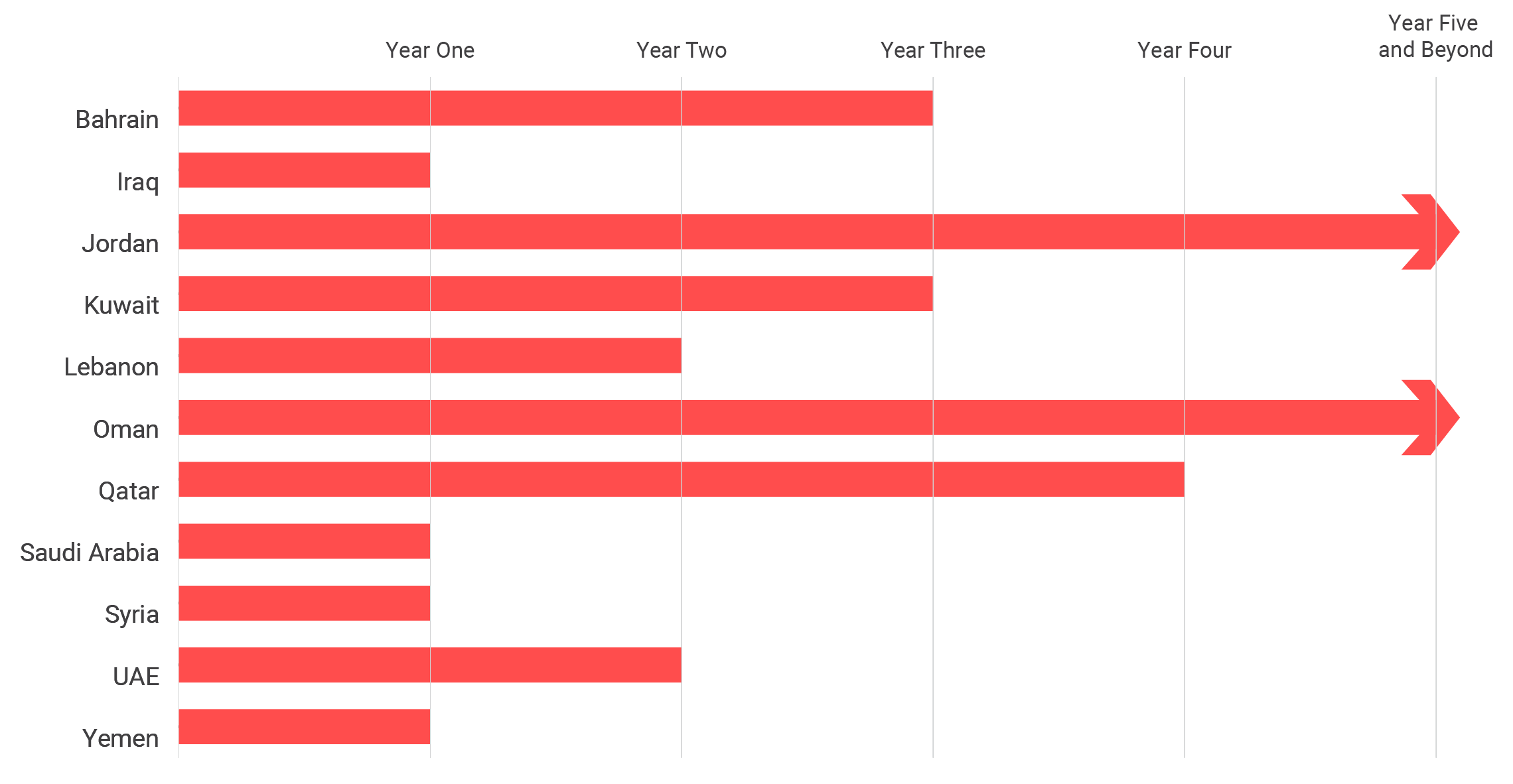
The U.S. could remove much of its troop presence in the Middle East within four years in part by making Jordan and Oman the main centers of operation in the region. It could then assess whether to withdraw remaining U.S. forces from those two countries and at what pace.
While these forces are being withdrawn, troop levels might actually rise slightly at Muwaffaq Salti in Jordan and at various facilities in Oman, as the United States continues to retreat away from the Middle East’s interior toward the periphery. With the intention made public to withdraw from Bahrain, naval deployments in the Gulf would also ebb and Duqm and Salalah in Oman would take on a more prominent role for U.S. ships operating in the northwest portion of the Indian Ocean. Neither port would be a one-off replacement for Manama and its dedicated facilities, but rather would serve as “normal” ports of call, with depth necessary to accommodate aircraft carriers if needed (in the case of Duqm) and locations that obviate the need to transit the Strait of Hormuz. Salalah also has the advantage of being well outside the range arc of Iran’s Fateh-110, while Duqm is on its cusp.
The third year would be the most consequential. This is when withdrawal would be finalized in both Bahrain and Kuwait, ending U.S. presence at the two strongest pillars of its Gulf presence. Also, in the third year, reductions would begin in Qatar, preparing for the final departure of standing forces from the Gulf. This would occur at the end of the fourth year when U.S. forces finally decamp Al Udeid; CENTCOM’s forward headquarters could be temporarily relocated to Muwaffaq Salti or possibly withdrawn altogether, back to the United States.
At this point, the United States would have divested about 35,000 ground troops from the region, including from as many as three active combat zones. A cessation to carrier deployments could mean an additional 15,000 or more personnel out of the region. Collectively, that would be a reduction of 50,000 in just four years.
Proposed U.S. footprint after four years
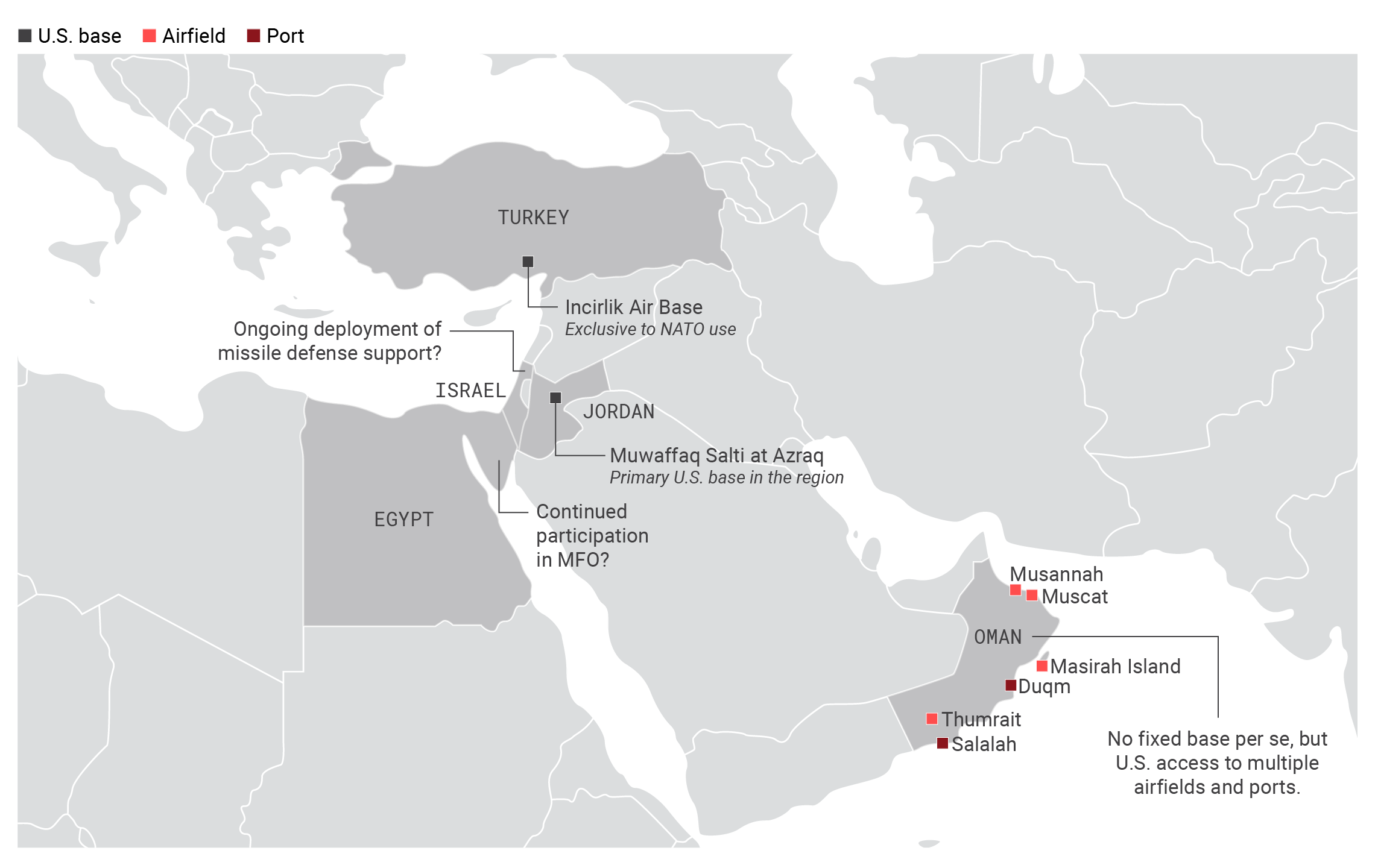
After four years, the U.S. could create a military presence in the Middle East that more accurately reflects the true importance of the region to the security and prosperity of the country
Phase two and the endgame
At the end of the first four years of the plan, the U.S. posture in the region would then be focused primarily on Jordan, with the air base at Azraq, and in Oman, where there would be access to additional airfields and, more importantly, two port facilities. This would roughly harken back to the level of presence the United States maintained for much of the Cold War when its main facilities were an air base in Turkey and a port in Bahrain.
Such reductions would set up the final inflection point: Should the United States continue its withdrawal from these two states, or should it proceed with them as a basis for it to return to the role of offshore balancer? The position of this paper all along has been that Oman and Jordan are not long-term solutions, simply acceptable waystations, with advantageous geography. However, if policy debate were to turn against a final departure of its forces from the region, the United States would still be far better off for the divestiture of bases made during the first half of this plan and its new alignment at Jordan and Oman.
That said, neither country is a panacea, even as each has a reputation for stability and moderate foreign policies. Both are still subject to the same social and economic forces that could enable a more tumultuous sequel to the Arab Spring. Only two years ago, Jordan experienced some of the region’s most intense protests since 2011, resulting in the ouster of the prime minister.52Suha Ma’ayeh and Raja Abdulrahim, “Jordan’s Prime Minister Steps Down in Wake of Protests,” Wall Street Journal, June 4, 2018, https://www.wsj.com/articles/jordans-prime-minister-steps-down-in-wake-of-protests-1528128116. Both countries are thus best thought of as useful steppingstones toward a regional exit, not permanent positions. Quitting these two countries—and essentially ending U.S. presence in the Middle East—within an additional four years (eight years total from the initial drawdowns proposed above) should be the preferred course.
What the plan does not cover
The reader will note that there are a few important deployments not covered in either the first or second phase of the withdrawal plan. This is deliberate and is largely intended as a bureaucratic and political expedient. The deployments in Israel and in Egypt (as part of the MFO policing the 1979 peace treaty between the two states) both touch on the unique U.S.-Israeli relationship. They are not a great number of forces and, in the case of troops manning the X-band radar in the Negev, contribute an advanced sensor capability to Israel’s missile defenses and also would facilitate the rapid introduction of U.S. THAAD interceptors in the event of a crisis.53The X-band radar is essentially the THAAD system’s “eyes.” The U.S. Army conducted a practice deployment of THAAD interceptors to Israel during the first half of 2019. See Joseph Trevithick, “U.S. Sends THAAD To Israel For First Time As Both Countries Slam Iran’s Missile Programs,” Drive, March 4, 2019, https://www.thedrive.com/the-war-zone/26749/u-s-sends-thaad-to-israel-for-first-time-as-both-countries-slam-irans-missile-programs. Maintaining a few dozen specialists to support this mission might be an acceptable commitment.
The MFO is more complicated. Multiple administrations have debated continuing the U.S. commitment to the peacekeeping force and the size of U.S. forces has been reduced over time.54U.S. Library of Congress, Congressional Research Service, Possible Withdrawal of U.S. Peacekeepers from the Sinai Peninsula, IN11403 (May 25, 2020), https://fas.org/sgp/crs/mideast/IN11403.pdf. Objections from Israel and Egypt, as well as pressure from Congress, have always prevented the United States from fully abandoning the mission. That said, the recent deaths of five U.S. service members attached to the MFO in a helicopter accident might spark a renewed review of this mission.55Nancy A. Youssef and Jared Malsin, “Five U.S. Troops Killed in Helicopter Crash Near Egypt,” Wall Street Journal, November 12, 2020, https://www.wsj.com/articles/six-u-s-troops-killed-in-helicopter-crash-near-egypt-11605196180.
The point is that neither the Negev nor Sinai mission would be worth holding up a broader withdrawal from the Persian Gulf, which, again, forms the meat of the U.S. Middle East presence. The small deployments in Egypt and Israel can be cordoned off and resolved in their own time.
Incirlik: Ghost base
The same is true of the future of U.S. presence in Turkey. At this point, it is almost impossible to fully list the sources of friction between Ankara and Washington. A brief accounting finds differences over Syria and Libya, the S-400 air defense system and the F-35 fighter, Turkey’s steady drift toward authoritarianism, and its penchant for coming close to open maritime conflict with other NATO members.56Antoine Got, “Turkey’s Crisis with the West: How a New Low in Relations Risks Paralyzing NATO,” War on the Rocks, November 19, 2020, https://warontherocks.com/2020/11/turkeys-crisis-with-the-west-how-a-new-low-in-relations-risks-paralyzing-nato/. To say the relationship is poisoned is an understatement. But it is also complicated from a basing perspective by Turkey’s membership in NATO and the dual-status Incirlik has as both an alliance base and one which the United States has used in support of operations in the Middle East.
Turkey is not considered directly in the withdrawal plan put forth in this paper because a U.S. departure from the region should not hinge on untangling this complicated web of issues. Moreover, from the perspective of the U.S. posture in the Middle East, Incirlik should be seen for what it is: a ghost base. Use of the facility for operations outside of NATO auspices has always been complicated by the fact that such action requires the permission of the Turkish parliament whereas NATO operations simply require the consent of the Turkish president.57Aaron Stein, “Bilateral Basing Squabbles: Incirlik and America’s Out of Area Wars,” Atlantic Council, August 29, 2018, https://www.atlanticcouncil.org/blogs/menasource/bilateral-basing-squabbles-incirlik-and-america-s-out-of-area-wars/. Muwaffaq Salti in Jordan has steadily been built up by the United States for a reason—an understanding of Incirlik’s increasing limitations as a base for operations to its south.58As one former U.S. official told the Atlantic in 2019, “Truth is, we can’t do much at Incirlik. We need Turkey’s permission to blow our nose there.” As quoted in Kathy Gilsinan, “Why Is Turkey in NATO Anyway?” Atlantic, October 11, 2019, https://www.theatlantic.com/politics/archive/2019/10/turkey-and-nato-troubled-relationship/599890/.
The only option is to acknowledge that whatever utility Incirlik still has for U.S. forces, it is strictly confined to its role under NATO auspices. In this regard, the fact that both Israel and Turkey fall under European Command’s domain, instead of CENTCOM—a geographic anomaly born of political realities—actually works in favor of separating the deployments in these two states from the broader execution of a U.S. withdrawal from the Middle East.
Conclusion
Four years to downsize the core of U.S. presence in the heart of the GCC to a peripheral position in Jordan and Oman is a relatively short period of time. Yet it could extricate 50,000 U.S. personnel from the region and fundamentally realign U.S. global military posture. It would also set the stage for additional withdrawals and a permanent departure of U.S. military forces from the Middle East. The relief such changes might provide to the U.S. force structure and budget could be critical as defense planners attempt to balance responsibly against challenges in other regions of the world, like East Asia.
This paper was written with a full understanding that such a withdrawal is not imminent. But it is put forward in an environment where more circumspect discussions are finally taking place on the Middle East’s value in U.S. foreign policy and the necessity and nature of U.S. presence there. The approach suggested in this paper hopefully can serve as a basis for further debate on how the United States positions its forces, while at the same time illustrating that a complete withdrawal is neither a logistical impossibility nor strategically anathema.
Critiques, revision, and commentary on this document are thus welcome not only from a purely intellectual standpoint, but from a practical one as well. The more we talk about how to leave the region the more realistic it becomes that we can. Ike’s maxim about planning remains true: the process of thinking through a departure from the Middle East is critical, even if the specific steps end up being different than what are identified above.
Endnotes
- 1Though neither explicitly advocates for a full withdrawal of all U.S. military forces from the region, two excellent discussions of the changed strategic relevance of the Middle East can be found in Mara Karlin and Tamara Coffman Wittes, “America’s Middle East Purgatory: The Case for Doing Less,” Foreign Affairs (January/February 2019): 88–100, https://www.foreignaffairs.com/articles/middle-east/2018-12-11/americas-middle-east-purgatory, and Martin Indyk, “The Middle East Isn’t Worth It Anymore,” Wall Street Journal, January 17, 2020, https://www.wsj.com/articles/the-middle-east-isnt-worth-it-anymore-11579277317.
- 2Within the academic and think tank communities, there are essentially four schools of thought on U.S. force posture in the Middle East. The first retains the current U.S. footprint while offering modest reductions in total number of forces. (See Joshua Rovner and Caitlin Talmadge, “Hegemony, Force Posture, and the Provision of Public Goods: The Once and Future Role of Outside Powers in Securing Persian Gulf Oil,” Security Studies 23 (2014) 548–581, and Bruce Reidel and Michael O’Hanlon, “How to Downsize the U.S. Presence in the Middle East,” Brookings Institution, October 20, 2020, https://www.brookings.edu/blog/order-from-chaos/2020/10/20/how-to-downsize-the-us-presence-in-the-middle-east/.) The second goes further, advocating for deeper cuts and consolidation of bases while maintaining the basic tenet of the United States retaining a military presence on the ground in the Middle East. (See Melissa G. Dalton and Mara E. Karlin, “Toward A Smaller, Smarter Force Posture in the Middle East,” Defense One, August 26, 2018, https://www.defenseone.com/ideas/2018/08/toward-smaller-smarter-force-posture-middle-east/150817/, and Mara E. Karlin and Tamara Cofman Wittes, “How to Do More with Less in the Middle East,” Foreign Affairs, September 15, 2020, https://www.foreignaffairs.com/articles/middle-east/2020-09-15/how-do-more-less-middle-east.) A third perspective argues for far more significant cuts, especially to ground forces, and the retention of very limited assets—like small naval forces, reconnaissance assets, and prepositioned equipment—that would allow the United States to play the role of offshore balancer, as it did for much of the Cold War. (See Emma Ashford, “Unbalanced: Rethinking America’s Commitment to the Middle East,” Strategic Studies Quarterly (Spring 2018): 127–148, https://www.cato.org/sites/cato.org/files/articles/ashford-ssq-november-2018.pdf, and Emma Ashford, “Better Balancing in the Middle East,” in U.S. Grand Strategy in the 21st Century, eds. A. Trevor Thrall and Benjamin H. Friedman [New York: Routledge, 2018]: 179–197.) Finally, a fourth school lobbies for full and complete withdrawal. (See Justin T. Logan, “The Case for Withdrawing from the Middle East,” Defense Priorities, September 2020, https://www.defensepriorities.org/explainers/the-case-for-withdrawing-from-the-middle-east.)
- 3For more on the British position in the Middle East post-World War II and their eventual departure, see Rovner and Talmadge, “Hegemony,” 560–554; Karol R. Sorby, “Great Powers and the Middle East after World War II (1945–1955),” Asian and African Studies 10, no. 1 (2001): 56–79; and Simon C. Smith, “Britain’s Decision to Withdraw from the Persian Gulf: A Pattern Not a Puzzle,” Journal of Imperial and Commonwealth History 44, no. 2 (December 8, 2015): 328–51.
- 4Mackenzie Eaglen, “Putting Combatant Commanders on a Demand Signal Diet,” War on the Rocks, November 9, 2020, https://warontherocks.com/2020/11/putting-combatant-commanders-on-a-demand-signal-diet/.
- 5Jonathan Masters and William Merrow, “How Is the U.S. Military Pivoting in Europe?” Council on Foreign Relations, September 23, 2020, https://www.cfr.org/in-brief/how-us-military-pivoting-europe.
- 6The figure of 42,000 is derived from the specific survey of U.S. forces in each of fourteen countries as laid out in this section of the paper. The high-end figure of 65,000, which includes rotational deployments, is taken from Eric Schmitt, “U.S. to Reduce Troop Levels in Iraq to 3,000,” New York Times, September 9, 2020, https://www.nytimes.com/2020/09/09/us/politics/iraq-troops-trump.html.
- 7“Text of a Letter from the President to the Speaker of the House of Representatives and the President Pro Tempore of the Senate,” The White House, December 11, 2019, https://www.whitehouse.gov/briefings-statements/text-letter-president-speaker-house-representatives-president-pro-tempore-senate-8/.
- 8“Statement from the President,” The White House, February 6, 2020, https://www.whitehouse.gov/briefings-statements/statement-from-the-president-13/.
- 9Eric Schmitt, “U.S. Sending More Troops to Syria to Counter Russia,” New York Times, September 18, 2020, https://www.nytimes.com/2020/09/18/us/politics/us-troops-syria-russia.html.
- 10Schmitt, “U.S. to Reduce Troop Levels in Iraq to 3,000”; Dan Lamothe and Missy Ryan, “As Trump’s Term Nears Close, Administration Announces Troop Level Cuts in Afghanistan and Iraq,” Washington Post, November 17, 2020, https://www.washingtonpost.com/national-security/trump-troop-cut-afghanistan-iraq/2020/11/17/ed6f3f80-28fa-11eb-b847-66c66ace1afb_story.html.
- 11U.S. Library of Congress, Congressional Research Service, The United Arab Emirates (UAE): Issues for U.S. Policy, RS21852 (September 4, 2020): 14, https://fas.org/sgp/crs/mideast/RS21852.pdf.
- 12U.S. Library of Congress, The United Arab Emirates (UAE), 14.
- 13U.S. Library of Congress, Congressional Research Service, Qatar: Governance, Security, and U.S. Policy, R44533 (August 31, 2020): 12, https://fas.org/sgp/crs/mideast/R44533.pdf.
- 14U.S. Library of Congress, Congressional Research Service, Bahrain: Unrest, Security, and U.S. Policy, 95-1013 (September 25, 2020): 12, https://fas.org/sgp/crs/mideast/95-1013.pdf.
- 15U.S. Library of Congress, Bahrain, 11.
- 16Richard McDaniel, “No ‘Plan B’: U.S. Strategic Access in the Middle East and the Question of Bahrain,” Brookings Institution, 2013, 16–17, https://www.brookings.edu/wp-content/uploads/2016/06/24-us-strategic-access-middle-east-bahrain-mcdaniel.pdf.
- 17U.S. Library of Congress, Congressional Research Service, Kuwait: Governance, Security, and U.S. Policy, RS21513 (October 14, 2020) 7–8, https://fas.org/sgp/crs/mideast/RS21513.pdf.
- 18U.S. Library of Congress, Kuwait, 8.
- 19Brian W. Everstine, “Cargo City Opens in Kuwait,” Air Power Magazine, May 28, 2019, https://www.airforcemag.com/cargo-city-opens-in-kuwait/.
- 20“Incirlik AB—Quick Overview,” Military Installations, https://installations.militaryonesource.mil/military-installation/incirlik-ab, and Miriam Berger, “Where U.S. Troops Are in the Middle East and Afghanistan, Visualized,” Washington Post, January 4, 2020, https://www.washingtonpost.com/world/where-us-troops-are-in-the-middle-east-and-could-now-be-a-target-visualized/2020/01/04/1a6233ee-2f3c-11ea-9b60-817cc18cf173_story.html.
- 21In FY2018 alone, $140 million was invested in improvements to Muwaffaq Salti Air Base; subsequent contracting documents call for a similar level of future investment to add additional mission-specific aprons and to improve housing, cargo storage, and revetments. See Joseph Trevithick, “Docs Show U.S. To Massively Expand Footprint at Jordanian Air Base Amid Spats With Turkey, Iraq,” Drive, January 14, 2019, https://www.thedrive.com/the-war-zone/25955/docs-show-us-to-massively-expand-footprint-at-jordanian-air-base-amid-spats-with-turkey-iraq.
- 22Berger, “Where U.S. Troops Are in the Middle East and Afghanistan, Visualized.”
- 23This assumes a reduction in 300 troops (those supporting the Patriot batteries) from the established estimate of 2,500 troops total having been based in Saudi Arabia. See Lolita C. Baldor, “U.S. Pulls Patriot Missiles, Fighter Aircraft from Saudi Arabia Amid Dispute,” Military Times, May 7, 2020, https://www.militarytimes.com/news/your-military/2020/05/07/us-pulls-patriot-missiles-fighter-aircraft-from-saudi-arabia-amid-dispute/.
- 24John Vandiver, “U.S. Troops Deployed to Israel Get a New Barracks,” Stars & Stripes, September 19, 2017, https://www.stripes.com/news/us-troops-deployed-to-israel-get-a-new-barracks-1.488440.
- 25“Text of a Letter,” The White House.
- 26“Text of a Letter,” The White House.
- 27U.S. Library of Congress, Oman: Politics, Security, and Policy, RS21534 (June 17, 2020): 13, https://fas.org/sgp/crs/mideast/RS21534.pdf.
- 28U.S. Library of Congress, Congressional Research Service, Oman, 13.
- 29Sune Engel Rasmussen and Gordon Lubold, “Omani Ports Give U.S. Navy Greater Control Over Strategic Waterway Near Iran,” Wall Street Journal, March 24, 2019, https://www.wsj.com/articles/omani-ports-give-u-s-navy-greater-control-over-strategic-waterway-near-iran-11553448471.
- 30McDaniel, “No ‘Plan B’: U.S. Strategic Access in the Middle East and the Question of Bahrain,” 15–16.
- 31U.S. Library of Congress, Oman, 13.
- 32“Major Non-NATO Ally Status,” Department of State, January 30, 2020, https://www.state.gov/major-non-nato-ally-status/.
- 33Specifically, at the start of 2010, the United States had 95,900 troops on the ground in Iraq; all were withdrawn by the end of 2011. See “Table 3. U.S. Armed Forces and Contractor Personnel in Iraq,” in Library of Congress, Congressional Research Service, Department of Defense Contractor and Troop Levels in Afghanistan and Iraq: 2007–2018, R44116 (May 10, 2019): 13, https://fas.org/sgp/crs/natsec/R44116.pdf.
- 34David B. Larter, “What If the U.S. Stopped Sending Aircraft Carriers to the Arabian Gulf?” Defense News, May 2, 2018, https://www.defensenews.com/naval/2018/05/02/what-if-the-us-stopped-sending-aircraft-carriers-to-the-arabian-gulf/; David B. Larter, “With Iran Tensions High, a U.S. Military Command Pushes a Dubious Carrier Strategy,” Defense News, March 24, 2020, https://www.defensenews.com/naval/2020/03/24/with-iran-tensions-high-centcom-pushes-a-dubious-carrier-strategy/; Megan Eckstein, “No Margin Left: Overworked Carrier Force Struggles to Maintain Deployments After Decades of Overuse,” USNI News, November 12, 2020, https://news.usni.org/2020/11/12/no-margin-left-overworked-carrier-force-struggles-to-maintain-deployments-after-decades-of-overuse.
- 35Larter, “With Iran Tensions High, a U.S. Military Command Pushes a Dubious Carrier Strategy.”
- 36McDaniel, “No ‘Plan B’: U.S. Strategic Access in the Middle East and the Question of Bahrain,” 15–16, 18–19.
- 37Ian Williams, “Uncomfortable Lessons: Reassessing Iran’s Missile Attack,” Center for Strategic and International Studies, February 6, 2020, https://www.csis.org/analysis/uncomfortable-lessons-reassessing-irans-missile-attack, and Stratford Worldview, “Yes, Iran’s Ballistic Missiles Are Pretty Accurate,” National Interest, August 22, 2020, https://nationalinterest.org/blog/reboot/yes-irans-ballistic-missiles-are-pretty-accurate-167511.
- 38Victor Abramowicz, “The Impact of Accuracy,” Interpreter, January 16, 2020, https://www.lowyinstitute.org/the-interpreter/impact-accuracy.
- 39See “Iranian Ballistic Missile Ranges” range-arc map in Defense Intelligence Agency, Iran Military Power (Washington, DC: Government Printing Office, 2019): 43, https://www.dia.mil/Portals/27/Documents/News/Military%20Power%20Publications/Iran_Military_Power_LR.pdf.
- 40Defense Intelligence Agency, Iran Military Power, 30–31, 43–36.
- 41Brian W. Everstine, “AFGSC’s New Plan to Deploy Bombers Across the Globe,” Air Force Magazine, April 29, 2020, https://www.airforcemag.com/afgscs-new-plan-to-deploy-bombers-across-the-globe/; Brian W. Everstine, “Iranian Ballistic Missile Launch Briefly Raises Alarm at Al Udeid, Al Dhafra,” Air Force Magazine, July 28, 2020, https://www.airforcemag.com/iranian-ballistic-missile-launch-briefly-raises-alarm-at-al-udeid-al-dhafra/.
- 42For example, the Iranian missile challenge factors prominently in the discussion of another alternative Middle East basing footprint put forward as this paper was going to publication. See Becca Wasser and Aaron Stein, “Small, Distributed, and Secure: A New Basing Architecture for the Middle East,” War on the Rocks, December 16, 2020, https://warontherocks.com/2020/12/small-distributed-and-secure-a-new-basing-architecture-for-the-middle-east/.
- 43Micah Zenko, “U.S. Policy in the Middle East: An Appraisal,” Chatham House Research Paper, October 2018, 7–8, https://www.chathamhouse.org/sites/default/files/publications/research/2018-10-18-us-military-policy-middle-east-zenko-final.pdf.
- 44Mike Sweeney, “Considering the ‘Zero Option’—Cold War Lessons on U.S. Basing in the Middle East,” Defense Priorities, March 2020, https://www.defensepriorities.org/explainers/considering-the-zero-option.
- 45Mike Sweeney, “Nothing is Forever: When the U.S. Military Eventually Leaves the Middle East, It’s Going to Need a Plan,” Modern War Institute, July 15, 2019, https://mwi.usma.edu/nothing-forever-us-military-eventually-leaves-middle-east-going-need-plan/.
- 46Sarah E. Yerkes, “The Tunisia Model,” Foreign Affairs 98, no. 6 (2019): 67–72, https://www.foreignaffairs.com/articles/tunisia/2019-10-15/tunisia-model.
- 47Marwan Muasher, “The Next Arab Uprising,” Foreign Affairs 97, no. 6 (2018): 113–24, https://www.foreignaffairs.com/articles/middle-east/2018-10-15/next-arab-uprising; Maha Yahya, “The Middle East’s Lost Decades,” Foreign Affairs 98, no. 6 (2019): 48–55, https://www.foreignaffairs.com/articles/middle-east/2019-10-15/middle-easts-lost-decades.
- 48Andrew A. Hill, “Black Swan, Red Beard: Recognizing the Unexpected,” War Room, United States Army War College, June 22, 2017, https://warroom.armywarcollege.edu/articles/black_swan_red_beard/.
- 49Muasher, “The Next Arab Uprising.” For an extensive discussion of various facets of the rentier model in the region, see also The Politics of Rentier States in the Gulf, Project on Middle East Political Science, January 2019, https://www.bakerinstitute.org/media/files/files/df77a3f0/krane-subsidies-pomeps.pdf.
- 50Ross Colvin, “Obama Speaks to Bahrain’s King, Urges Restraint,” Reuters, February 18, 2011, https://www.reuters.com/article/us-bahrain-usa/obama-speaks-to-bahrains-king-urges-restraint-idUSTRE71H5L420110219; Ethan Brockman and Michael Slackman, “Saudi Troops Enter Bahrain to Help Put Down Unrest,” New York Times, March 14, 2011, https://www.nytimes.com/2011/03/15/world/middleeast/15bahrain.html; Max Fisher, “Obama’s UN Address and the Bahrain Exception,” Atlantic, September 21, 2011, https://www.theatlantic.com/international/archive/2011/09/obamas-un-address-and-the-bahrain-exception/245467/.
- 51Brian W. Everstine, “Heat from the Desert,” Air Force Magazine, October 9, 2017, https://www.airforcemag.com/article/heat-from-the-desert/.
- 52Suha Ma’ayeh and Raja Abdulrahim, “Jordan’s Prime Minister Steps Down in Wake of Protests,” Wall Street Journal, June 4, 2018, https://www.wsj.com/articles/jordans-prime-minister-steps-down-in-wake-of-protests-1528128116.
- 53The X-band radar is essentially the THAAD system’s “eyes.” The U.S. Army conducted a practice deployment of THAAD interceptors to Israel during the first half of 2019. See Joseph Trevithick, “U.S. Sends THAAD To Israel For First Time As Both Countries Slam Iran’s Missile Programs,” Drive, March 4, 2019, https://www.thedrive.com/the-war-zone/26749/u-s-sends-thaad-to-israel-for-first-time-as-both-countries-slam-irans-missile-programs.
- 54U.S. Library of Congress, Congressional Research Service, Possible Withdrawal of U.S. Peacekeepers from the Sinai Peninsula, IN11403 (May 25, 2020), https://fas.org/sgp/crs/mideast/IN11403.pdf.
- 55Nancy A. Youssef and Jared Malsin, “Five U.S. Troops Killed in Helicopter Crash Near Egypt,” Wall Street Journal, November 12, 2020, https://www.wsj.com/articles/six-u-s-troops-killed-in-helicopter-crash-near-egypt-11605196180.
- 56Antoine Got, “Turkey’s Crisis with the West: How a New Low in Relations Risks Paralyzing NATO,” War on the Rocks, November 19, 2020, https://warontherocks.com/2020/11/turkeys-crisis-with-the-west-how-a-new-low-in-relations-risks-paralyzing-nato/.
- 57Aaron Stein, “Bilateral Basing Squabbles: Incirlik and America’s Out of Area Wars,” Atlantic Council, August 29, 2018, https://www.atlanticcouncil.org/blogs/menasource/bilateral-basing-squabbles-incirlik-and-america-s-out-of-area-wars/.
- 58As one former U.S. official told the Atlantic in 2019, “Truth is, we can’t do much at Incirlik. We need Turkey’s permission to blow our nose there.” As quoted in Kathy Gilsinan, “Why Is Turkey in NATO Anyway?” Atlantic, October 11, 2019, https://www.theatlantic.com/politics/archive/2019/10/turkey-and-nato-troubled-relationship/599890/.
More on Middle East

By Benjamin Friedman and Rosemary Kelanic
December 5, 2025
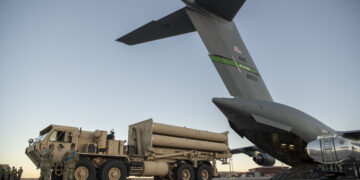
By Geoff LaMear
December 5, 2025
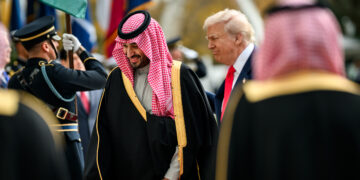
November 19, 2025
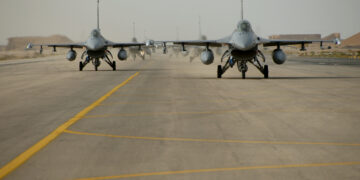
November 19, 2025
Events on Grand strategy
